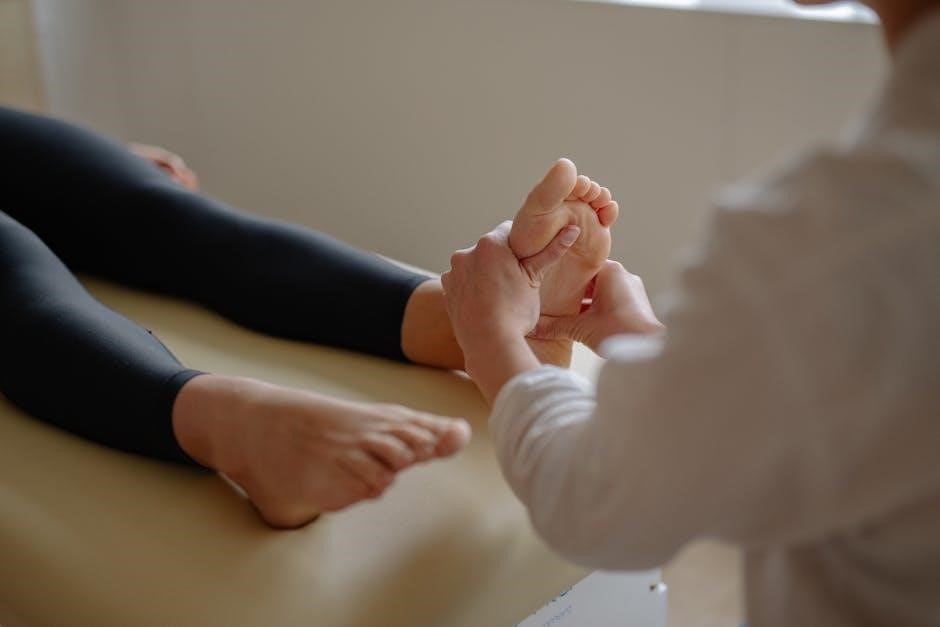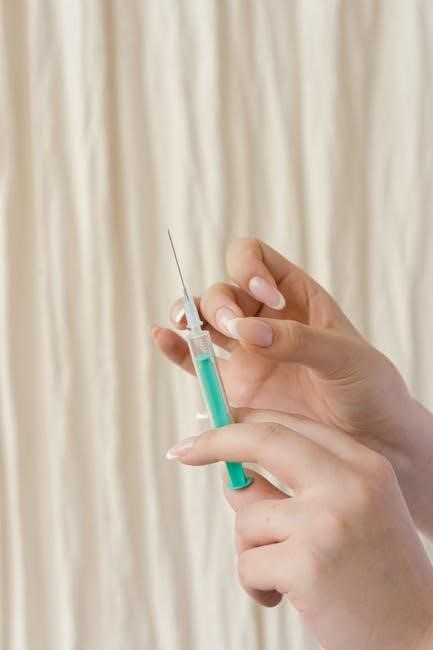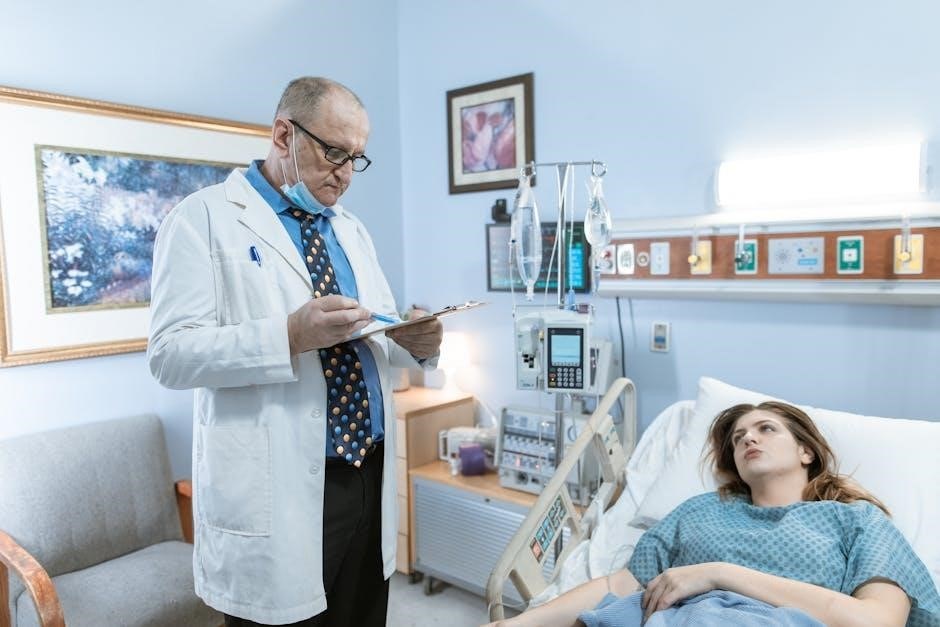
bed bug treatment preparation checklist pdf
Welcome to our comprehensive guide on bed bug treatment preparation․ Proper preparation is essential for effective treatment, ensuring the best results and minimizing future infestations․ This checklist provides detailed steps to help you prepare your home, including laundry, furniture preparation, and decluttering, ensuring a successful treatment process․

Understanding the Importance of Bed Bug Treatment Preparation
Thorough preparation is essential for effective bed bug treatment, ensuring successful elimination and preventing re-infestation․ Proper steps enhance treatment efficacy and safety, while inadequate preparation may lead to treatment failure and ongoing issues․
Why Preparation is Key to Successful Treatment
Preparation is crucial for effective bed bug treatment, as it directly impacts the outcome․ Cluttered spaces and untreated items can harbor bed bugs, reducing the treatment’s effectiveness․ Proper preparation ensures all areas are accessible and treated, minimizing hiding spots for bed bugs․ It also helps prevent re-infestation by addressing potential breeding grounds․ Without adequate preparation, treatments may fail to eliminate the infestation entirely, leading to ongoing problems․ Additionally, preparation ensures safety for both residents and pets, as it involves securing sensitive items and creating a clean environment for treatment․ By following a detailed checklist, homeowners can significantly improve the chances of successful treatment․ Proper preparation not only enhances the efficacy of treatments but also prevents the return of bed bugs, making it a cornerstone of any effective elimination strategy․
Consequences of Inadequate Preparation
Inadequate preparation for bed bug treatment can lead to reduced effectiveness, allowing bed bugs to survive and potentially re-infest the area․ Untreated areas or items may harbor bed bugs, making the treatment less successful․ This can result in the need for repeated treatments, increasing costs and time․ Additionally, improper preparation may leave behind eggs or live bugs, leading to a faster resurgence of the infestation․ Poorly prepared environments may also require more extensive treatments, such as multiple chemical applications or heat treatments․ Furthermore, inadequate preparation can delay recovery, causing prolonged discomfort and disruption to daily life․ It is essential to follow a comprehensive checklist to avoid these issues and ensure a successful treatment outcome․ Proper preparation is vital to eliminate bed bugs effectively and prevent future infestations․

Bed Bug Treatment Preparation Checklist
A comprehensive guide to ensure effective treatment, covering laundry, furniture, clutter removal, and thorough cleaning․ Follow these steps to eliminate hiding spots and guarantee successful bed bug elimination․
Laundry and Bedding
Begin by washing and drying all bedding, including sheets, pillowcases, and blankets, in hot water (at least 120°F) and high heat settings․ Dry clean or seal non-washable items in plastic bags for up to six months․ Launder clothing and fabrics in contact with beds, using similar hot water and heat settings․ Store cleaned items in sealed, bed bug-proof bags to prevent re-infestation․ Pay special attention to stuffed animals, curtains, and rugs, ensuring they are either washed or treated․ Vacuum mattresses and box springs before encasing them in bed bug-proof covers․ Dry cleaning is recommended for items that cannot be washed․ Remember to clean and dry any laundry baskets or hampers․ This step is crucial to eliminate bed bugs and their eggs from fabrics, ensuring effective treatment results․
Furniture and Mattress Preparation
Start by inspecting all furniture, especially mattresses, box springs, and upholstered items, for signs of bed bugs․ Remove any visible bed bugs or eggs using a stiff brush or vacuum cleaner with a hose attachment․ Wash and dry all bedding, as outlined in the previous section․ For non-washable items, such as stuffed furniture, use a hand steamer or seal them in plastic bags for at least six months․ Vacuum all surfaces thoroughly, paying attention to cracks, crevices, and seams․ After vacuuming, immediately dispose of the vacuum bag or empty the canister into a sealed trash bag․ Apply bed bug-proof encasements to mattresses and box springs, ensuring they remain in place for at least one year․ Move furniture away from walls to facilitate treatment access․ Finally, remove any items stored on or near beds to prevent re-infestation․ Proper preparation ensures the treatment targets all potential hiding spots effectively․
Decluttering and Organizing
Decluttering and organizing are essential steps in bed bug treatment preparation․ Start by removing unnecessary items from the affected area, as clutter provides hiding spots for bed bugs․ Sort items into categories: keep, donate, sell, or discard․ Dispose of items you no longer need, especially if they are infested․ For items you wish to keep, store them in sealed, bed bug-proof containers or plastic bins with tight-fitting lids․ Organize remaining belongings to reduce hiding places for bed bugs․ Vacuum and clean all surfaces before returning items to the room․ Avoid moving items from one room to another, as this can spread the infestation․ Keep the space tidy and ensure all stored items are elevated off the floor․ This helps pest control professionals access all areas effectively and ensures the treatment is thorough and successful․ A clutter-free environment makes it easier to monitor for future infestations․

Vacuuming and Cleaning
Vacuuming and cleaning are critical steps in bed bug treatment preparation․ Use a vacuum cleaner with a hose attachment to thoroughly clean carpets, rugs, mattresses, and box springs, especially around seams and crevices where bed bugs hide․ Pay special attention to areas near beds, such as headboards, nightstands, and baseboards․ After vacuuming, immediately empty the vacuum bag or canister into a sealed plastic bag and dispose of it outside to prevent bed bugs from escaping․ Additionally, wipe down all surfaces with a damp cloth, focusing on areas where bed bugs are likely to be present․ Avoid using harsh chemicals, as they may repel bed bugs and reduce the effectiveness of treatment․ Cleaning thoroughly ensures that pest control measures can target the bed bugs more effectively․ This step also helps reduce the overall number of bed bugs, improving the chances of a successful treatment․
Handling Non-Washable Items
Non-washable items, such as stuffed animals, curtains, or shoes, require special attention during bed bug treatment preparation․ These items should be sealed in plastic bags or containers with tight-fitting lids to prevent bed bugs from escaping or re-infesting the area․ Label the bags with the date and contents for easy identification․ If possible, place the items in a dryer on high heat for at least 20 minutes to kill bed bugs and eggs․ Alternatively, items that cannot be heated can be left in sealed bags for up to six months․ Dry cleaning is another option for items that can tolerate it․ Ensure all non-washable items are thoroughly inspected before being returned to their original places․ Proper handling of these items is essential to ensure the treatment’s success and prevent future infestations․ Always follow professional advice for items of sentimental or monetary value․
Preparing for Heat Treatment
Preparing for heat treatment involves specific steps to ensure safety and effectiveness․ Start by removing heat-sensitive items such as plastics, electronics, and aerosols, as high temperatures can damage these․ Seal any items that cannot be removed, like mirrors or televisions, using heat-resistant coverings․ Clear the room of flammable materials and ensure all windows and doors are closed to maintain consistent heat levels․ Washable items should be laundered and sealed in bags, while non-washable items can be treated in the heat or stored in sealed containers; The treatment area must be free from clutter to allow proper air circulation․ After treatment, ventilate the space thoroughly to remove any lingering heat or chemical odors․ Always follow the guidelines provided by professionals to ensure the heat treatment is safe and effective․ Proper preparation is crucial for achieving optimal results and eliminating bed bugs completely․ This step ensures the treatment targets all areas effectively․
Securing Pets and Aquariums
Securing pets and aquariums is a critical step in bed bug treatment preparation to ensure their safety and well-being․ All pets, including dogs, cats, birds, and small animals, should be removed from the treatment area and kept in a bed bug-free environment․ Aquariums and fish tanks must be covered with plastic wrap or a tight-fitting lid to prevent chemical contamination or heat exposure during treatment․ Filters and air pumps should be turned off temporarily to avoid circulating treated air․ Food and water for pets should be prepared in advance and stored outside the treatment zone․ After treatment, thoroughly inspect and clean pet areas before reintroducing them․ This ensures pets are protected from potential harm and prevents re-infestation from items they may carry․ Always consult professionals for guidance on handling exotic or sensitive pets․ Proper precautions ensure the safety and health of both pets and aquarium life during the treatment process․

Special Considerations
Special considerations are essential for different living situations, such as apartments, homes, and hotels, each requiring tailored strategies to address unique challenges and ensure effective treatment․ Cooperation and professional guidance are key․
Preparation for Apartment Dwellers
Apartment dwellers face unique challenges due to shared walls and proximity to neighbors․ Begin by notifying your landlord or property manager to ensure coordinated treatment efforts․ Wash and dry all bedding, including mattresses and box springs, on high heat․ Vacuum thoroughly, especially around beds and furniture, and dispose of the vacuum bag immediately․ Declutter and organize living spaces to reduce hiding spots for bed bugs․ Cover mattresses and box springs with protective encasements․ Seal cracks and crevices around windows, doors, and baseboards using caulk or putty․ Treat non-washable items with diatomaceous earth or pack them in sealed plastic bags for at least six months․ Keep communication open with neighbors to prevent re-infestation and schedule follow-up treatments as recommended by professionals․ Proper preparation ensures effective treatment in multi-unit living environments․
Preparation for Homeowners
Homeowners must take comprehensive steps to prepare for bed bug treatment, ensuring the entire property is addressed․ Start by inspecting all rooms, paying attention to beds, furniture, and carpets, and identify areas with high bed bug activity․ Wash and dry all bedding, curtains, and washable rugs on high heat․ Dry clean or seal in plastic bags non-washable items for at least six months․ Vacuum all carpets, rugs, and upholstered furniture, then dispose of the vacuum bag or empty the canister immediately․ Declutter and organize living spaces to eliminate hiding spots․ Treat yard areas near the home, as bed bugs can migrate from outdoor sources․ Seal cracks and crevices around windows, doors, and pipes using caulk or steel wool․ Use mattress encasements and ensure all treated areas are accessible for professionals․ Dispose of heavily infested items responsibly to prevent spreading the infestation․ Proper preparation by homeowners is critical for effective treatment and preventing future issues․
Preparation for Hotel Rooms
Preparing hotel rooms for bed bug treatment requires meticulous attention to detail to maintain guest satisfaction and reputation․ Start by conducting a thorough inspection of the room, focusing on mattresses, box springs, headboards, and bedding․ Wash and dry all linens, including blankets and towels, on high heat settings․ Dry clean or seal non-washable items in plastic bags for at least six months․ Declutter the room, removing any unnecessary items, and organize belongings to minimize hiding spots․ Vacuum carpets, rugs, and upholstered furniture thoroughly, especially around seams and crevices․ Ensure all electrical outlets and switches are accessible for inspection and treatment․ Coordinate with pest control professionals to schedule treatments during low occupancy periods․ Inform staff and housekeeping teams about the importance of preparation and maintain clear communication with guests to avoid misunderstandings․ Proper preparation ensures effective treatment and helps prevent future infestations in a high-traffic environment like hotels․

Post-Treatment Care
Post-treatment care involves allowing treatments to take full effect, avoiding re-introducing items too soon, and maintaining cleanliness to prevent re-infestation․
Follow-Up Treatments
Follow-up treatments are essential to ensure complete elimination of bed bugs, as a single treatment is rarely sufficient․ Typically, treatments are spaced 7-10 days apart to target newly hatched nymphs․ Professionals may use alternate methods or chemicals in follow-ups to avoid resistance․ Residents should adhere strictly to the schedule provided by pest control experts․ Before each follow-up, it’s crucial to repeat pre-treatment preparations, such as washing bedding and vacuuming thoroughly․ Follow-ups may also involve monitoring devices or traps to assess treatment effectiveness․ In severe infestations, multiple sessions could be necessary․ Consistency and patience are key, as skipping follow-ups can lead to re-infestation․ Proper communication with your pest control provider ensures tailored strategies and better outcomes․
Monitoring for Re-Infestation
Monitoring for re-infestation is a critical step after bed bug treatment to ensure the problem is fully resolved․ Regular inspections should be conducted weekly, focusing on areas like mattresses, box springs, and headboards․ Use a magnifying glass or flashlight to spot tiny bugs, eggs, or shed skins․ Install bed bug interceptors under legs of furniture to capture and identify any movement․ Wash and dry bedding on high heat settings regularly to eliminate potential survivors․ Keep mattress encasements in place to prevent re-infestation․ Be vigilant for signs like new bites or musty odors․ Early detection is key to preventing a full-blown infestation․ Maintain a clean and clutter-free environment to reduce hiding spots․ If any signs reappear, contact a professional immediately․ Consistent monitoring ensures long-term success and peace of mind․

Signs of Successful Treatment
A successful bed bug treatment is evident when bites decrease, live bugs disappear, and eggs or shed skins are no longer visible․ The distinctive odor of bed bugs fades, signaling eradication․
Reduction in Bites
A noticeable reduction in bites is one of the most immediate signs of successful bed bug treatment․ As the infestation is brought under control, the frequency and severity of bites will decrease․ This is especially evident in the days and weeks following treatment, as the bed bug population dwindles․ It’s important to monitor this closely, as bites can sometimes persist due to residual bugs or delayed reactions․ However, if bites continue unabated, it may indicate incomplete treatment or re-infestation․ Properly prepared environments, as outlined in a bed bug treatment preparation checklist, play a crucial role in achieving this reduction․ Ensure all areas are thoroughly inspected and treated to maximize the effectiveness of the treatment and minimize the likelihood of ongoing bites․ If bites persist, consult a professional for further evaluation and assistance․
Decrease in Bug Sightings
A significant decrease in bed bug sightings is a clear indicator that treatment efforts are proving effective․ After proper preparation and treatment, the visible presence of bed bugs should diminish notably․ This is especially true when the environment has been thoroughly cleaned and decluttered, as outlined in a bed bug treatment preparation checklist․ Reducing clutter and washing bedding and clothing helps eliminate hiding spots, making it easier to spot and eliminate remaining bugs․ As the infestation is controlled, live bugs become less visible, especially in areas like mattresses, box springs, and headboards․ However, it’s important to remain vigilant, as straggler bugs may still appear․ Regular monitoring and follow-up treatments are essential to ensure complete eradication․ A noticeable decline in bug sightings is a strong sign that the treatment is working, but it’s crucial to continue monitoring to prevent re-infestation․

DIY vs․ Professional Treatment
DIY treatments can be cost-effective but often require significant time and effort․ Professional treatments, while more expensive, offer expertise and specialized equipment, especially for severe infestations․
Pros and Cons of DIY Methods
DIY bed bug treatment methods can be cost-effective and allow individuals to handle infestations privately․ They often involve using over-the-counter pesticides, heat treatment tools, or natural remedies like essential oils․ A significant advantage is the immediate availability of these methods, enabling quick action․ However, DIY treatments can be time-consuming and may require repeated applications․ Additionally, improper use of chemicals can lead to health risks or further pest resistance․ Many DIY methods lack the effectiveness of professional-grade treatments, especially in severe infestations․ Without proper preparation and knowledge, DIY efforts may fail to eliminate all bugs, leading to prolonged infestations․ While DIY can be a good starting point, it may not be sufficient for large or persistent problems, emphasizing the importance of understanding its limitations․
When to Call a Professional

Calling a professional is essential when dealing with severe or widespread bed bug infestations that DIY methods cannot effectively address․ If the infestation persists despite repeated attempts at self-treatment, professional intervention becomes necessary․ Professionals possess specialized equipment, such as industrial-grade heaters and chemical treatments, ensuring thorough elimination of bed bugs and their eggs․ Additionally, they have the expertise to identify and target hiding spots that are often missed in DIY efforts․ Time constraints or lack of knowledge about proper preparation and treatment techniques also make hiring a professional a viable option․ Furthermore, if the infestation spans multiple rooms or is present in complex structures like multi-unit buildings, professional treatment is the most reliable solution․ Finally, if you or others in the household are particularly sensitive to bites or chemicals, a professional can provide safer, more efficient results․

Preventative Measures
Regular inspections and proactive steps are crucial to prevent bed bug infestations․ Use mattress encasements, inspect second-hand items, and educate household members on recognition and prevention strategies․
Regular Inspections
Regular inspections are a cornerstone of effective bed bug prevention․ Start by examining bedding, mattresses, and box springs for signs of bed bugs, such as live insects, eggs, or shed skins․ Use a magnifying glass or flashlight to spot these tiny pests in cracks and crevices․ Pay attention to areas around the bed, including headboards, nightstands, and nearby furniture․ Inspect upholstered items, behind wallpaper, and along carpet edges as well․ Wash and dry bedding on high heat weekly to eliminate any potential bugs․ Vacuum rugs and mattresses regularly, especially around seams and edges․ Encase mattresses and box springs in bed bug-proof covers to trap any remaining bugs․ If you notice even a single bug, act promptly to prevent infestation․ Early detection is key to avoiding costly and time-consuming treatments․ Regular inspections ensure a proactive approach to managing bed bugs effectively․
Travel Precautions
Traveling can often lead to bed bug infestations if proper precautions are not taken․ Always inspect your hotel room thoroughly upon arrival, focusing on mattresses, headboards, and box springs․ Use a flashlight to check for live bugs, eggs, or dark spots in cracks and crevices․ Avoid placing luggage on the floor or bed; instead, use a hard, non-carpeted surface or luggage rack․ Keep your luggage sealed and away from walls․ Wash and dry all clothing immediately upon returning home, even if items were not worn․ Dry cleaning may also be necessary for non-washable items․ Consider sealing items in plastic bags until they can be cleaned․ When staying in shared spaces, remain vigilant and report any signs of bed bugs to management․ By taking these steps, you can significantly reduce the risk of bringing bed bugs back home․
Effective bed bug treatment begins with thorough preparation, as outlined in this comprehensive checklist․ By understanding the importance of each step, from laundry and decluttering to securing pets and preparing for heat treatment, homeowners and travelers alike can significantly improve treatment outcomes․ Remember, successful elimination of bed bugs requires patience, consistency, and attention to detail․ Post-treatment care, including follow-up inspections and monitoring, is essential to prevent re-infestation․ Whether opting for DIY methods or professional services, staying informed and proactive is key to maintaining a bed bug-free environment․ By adhering to these guidelines and adopting preventative measures, you can protect your home and reduce the risk of future infestations․ Always prioritize vigilance and timely action to ensure long-term success in your bed bug management efforts․